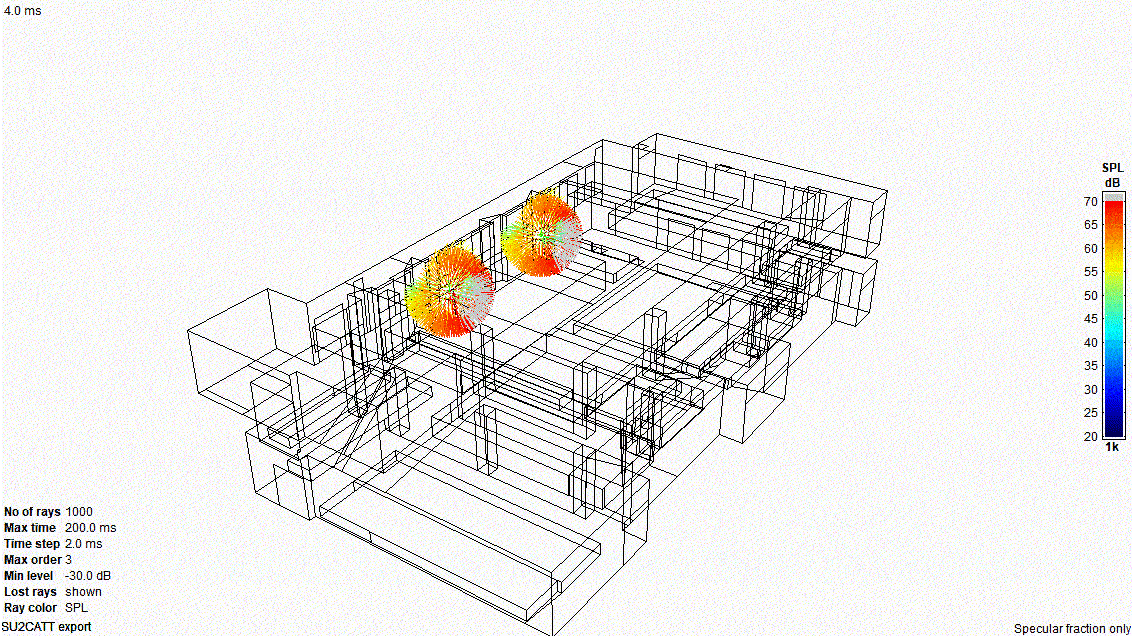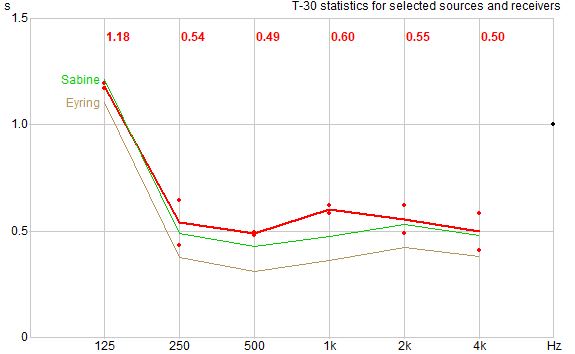Room Acoustics Modelling
Room acoustics modelling is crucial for creating optimal sound environments in spaces designed for speech and music. By analysing room finishes and reverberation patterns, we can ensure clear communication and appropriate acoustic properties for various purposes.
We work across the UK to provide room acoustics modelling services. Contact our team of expert acoustic engineers today to optimise the acoustics in your space and enhance the overall experience for speakers and listeners alike.

What is Room Acoustics Modelling?
Room acoustics modelling involves reviewing proposed or existing room finishes to investigate the reverberation pattern in rooms intended for speech (e.g., meeting/conference rooms, classrooms, lecture theatres), which require good acoustic conditions for speakers and listeners.
Why is Room Acoustics Modelling Important?
Room acoustics modelling is crucial for creating optimal sound environments. In areas such as conference rooms, classrooms, and lecture theatres, proper acoustics ensure speakers can be heard clearly and listeners can engage effectively without strain or distraction.
Room finishes determines the reverberation time of a room, which should be considered as this impacts the noise level within the space and the perception of both speech and music. There may be situations where clear speech is not the primary objective. In these cases, poor room acoustic parameters and, consequently, a long reverberation time can increase the background noise level, which in turn could lead to other undesirable effects.
What are the requirements?
General guidance on designing rooms for speech is given in British Standard BS 8233: 2014 ‘Guidance on sound insulation and noise reduction for buildings’.
Guide values for reverberation time for rooms of different volumes (for both speech and music) are given in BS 8233: 1999 ‘Sound insulation and noise reduction for buildings – Code of practice’, as shown in the table below.
| Room Volume (m2) | Reverberation Time (s) | |
| Speech | Music | |
| 50 | 0.4 | 1.0 |
| 100 | 0.5 | 1.1 |
| 200 | 0.6 | 1.2 |
| 500 | 0.7 | 1.3 |
| 1000 | 0.9 | 1.5 |
| 2000 | 1.0 | 1.6 |
Guide to reverberation time at 500 Hz in unoccupied rooms for speech and music
Building Bulletin 93, ‘ Acoustic design of schools: performance standards’, provides the requirements for reverberation times in school teaching and study spaces. These times depend on the space’s use and whether the building is newly built or a refurbishment of an existing building.
There are more stringent requirements for teaching spaces for students with special hearing or communication needs and separate requirements for sports halls and swimming pools.
What Types of Spaces Need Room Acoustics Modelling?
We work with all types of spaces, including:
-
Schools
-
Meeting rooms
-
Conference rooms
-
Places of worship
-
Sports halls and gyms
-
Theatres
-
Music studios
-
Restaurants and bars
-
Residential developments
-
Offices
-
Industrial environments
-
Commercial environments
At What Stage Should I Seek Room Acoustics Advice?
The rooms that will be used for speech should be recognised early in the design process. In addition to the room finishes (materials and distribution location throughout the room), the size and shape of spaces affect the acoustic conditions and, hence, reverberation time. Therefore, it is recommended that an acoustic consultant be engaged as early as possible within the project timeline.
Early engagement of an acoustic consultant allows for more innovative and efficient solutions. For instance, we can work closely with architects to explore creative ways of incorporating acoustic treatments that complement the space’s aesthetic vision. This collaboration can lead to multi-functional design elements for acoustic and visual purposes.
How Can We Help?
Our expert team of acoustic consultants works across the UK to help improve room acoustics. Our process includes:
1. Detailed acoustic calculations are undertaken to investigate the reverberation pattern within the required room(s), focusing on the specific requirements of the space(s). For developments that are not yet in the construction stage, this would be done based on a study of layout drawings and proposed surface finishes.
2. The calculated overall reverberation time is then compared with acceptable design ranges in relevant British Standards to ensure an adequate and functional acoustic environment.
3. We will issue a full report detailing the calculations undertaken and subsequent findings, including a full specification of room areas to be treated.
3D modelling can also be undertaken for particularly sensitive rooms using proprietary reverberation software, CATT Acoustics.
Room acoustic predictions in CATT Acoustics are carried out using geometrical acoustics principles. Predictions incorporate spectral (octave-band) calculations using 3D models of the room, which can be a CAD model (or other 3D model created using programs such as SketchUp) imported into CATT Acoustics. Absorption properties are assigned to each material and sound source that comprise the room surfaces, from which the sound reflections and reverberation time can be estimated. Using this tool, the effectiveness of different possible treatments can be accurately predicted to help find the optimal solutions for appropriate room acoustics.
The below figures indicate a 3D model of a room, as viewed in CATT acoustics, and an example of the reverberation time estimate output.


Why Choose Clement Acoustics?
Quick turnaround time
Helpful team of qualified acoustic engineers
Competitive rates
